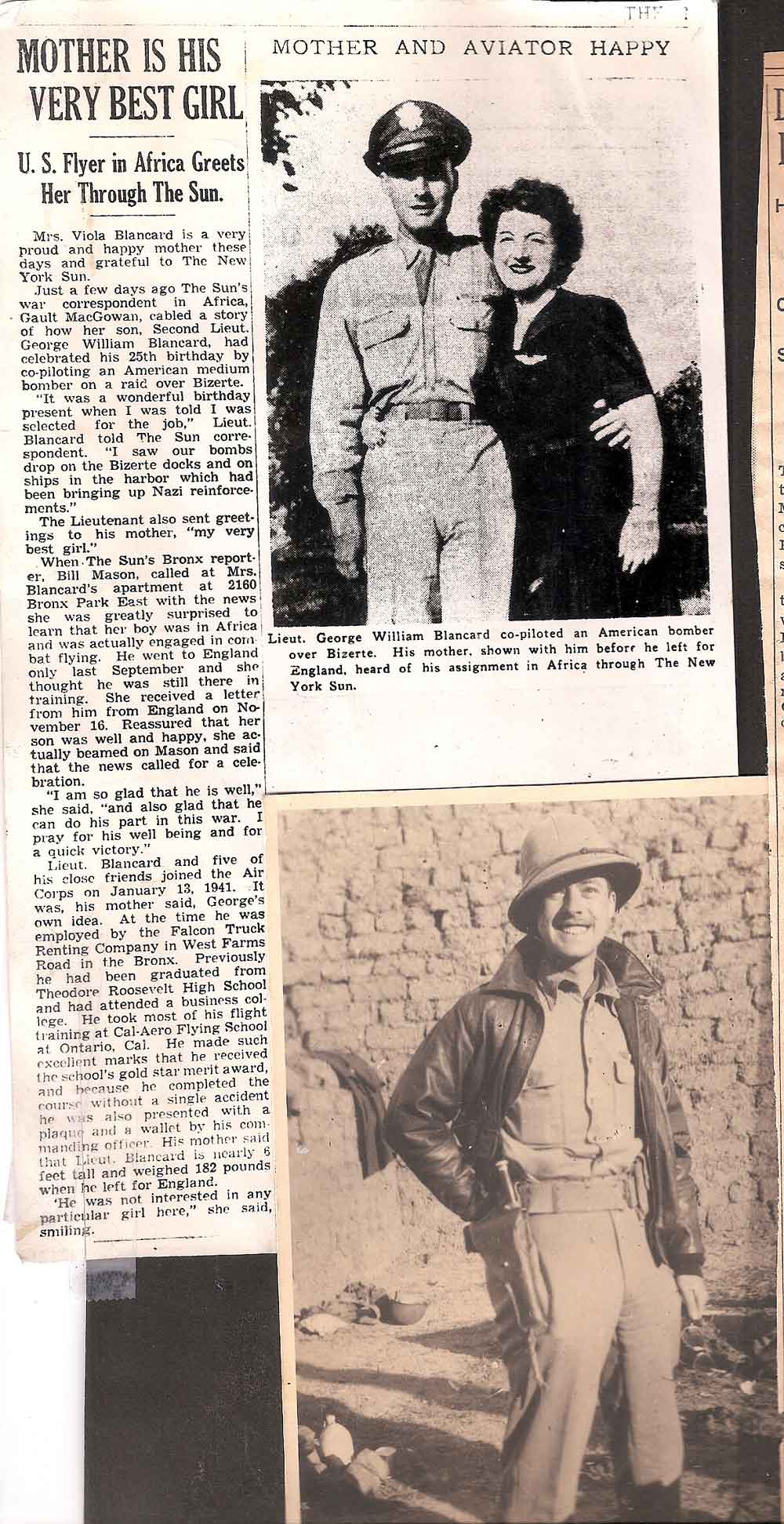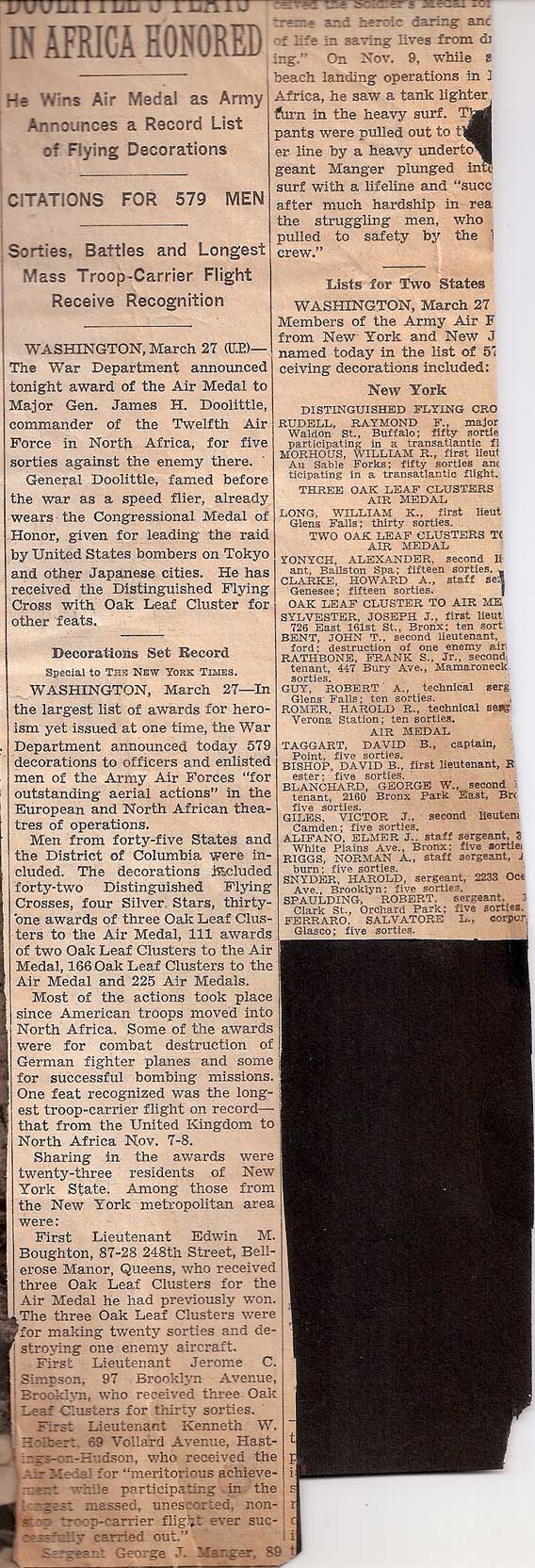|
|
Guest Book | Pages & Links |
George William Blancard
|
George W. Blancard 1917-1944
First Lieutenant George Blancard was born on 4 Dec 1917.
He enlisted in the Army Air Force on 27 Jan 1942 and was qualified in
these aircraft: BT-13, AT-8, PT-17, L-3, P-38, A-20, B-24, B-25, and B-26.
He flew B-26 in Europe for 14 months and received the Air Medal with seven
Oak Leaf Clusters. He had 900 hours of flying time and his flight records
from 1944 were included in the package. After completing his overseas tour
of duty, he was reassigned first in Wilmington, Delaware in January 1944,
and then as an instructor/ferry pilot based in Nashville, Tennessee from
18 May 1944. The B-26G that he flew that day was made in the Martin plant
at Offutt Field in Omaha, Nebraska, as were B-29s used against Japan
including the Enola Gay and Bockscar. It was painted with British markings
and was being delivered to Europe. It was headed to West Palm Beach,
Florida. That seemed strange until I realized that the southern ferry
route went through Puerto Rico, Trinidad, Guyana, Brazil, Ascension Island
and Africa.
My grandmother, Jennie Newman, had a younger sister, Frances. She married
Al Lubin, a theatrical producer in New York. She said she had a wonderful
life with Al. They had one daughter, Viola. Viola had one child, George.
She had said that George was the perfect child and was quite distraught by
his death. I was warned never to mention George to her when I was growing
up, so I never knew anything about him. She subsequently married Max
Mioduser. He owned Falcon Truck Renting on Long Island before he sold out
to Hertz and retired to a house with a boat on a canal near Miami,
Florida. After he passed, Viola moved to a condo near the beach in North
Miami where I finally met her in 1978. They had invited me to visit them
several times over the years, but I had not had permission from my
parents, the money, or the opportunity. Viola then moved in with her old
friend from New York, Hy Fishman, and disappeared. I never got the chance
to learn anything about George or even see a picture. |
***
| The following information was donated by Mr. Harvey Kaufman, and his daughter Melinda. Mr. Kaufman was a 1st Lieutenant, B17 Bombardier, and flew fifty (50) missions from June '43- Nov. '43. He knew Mr. Blancard for four years before the start of WW2, and saved these news clippings about his friend. |
| MOTHER IS HIS VERY BEST GIRL U.S. Flyer in Africa Greets Her Through The Sun Mrs. Viola Blancard is a very proud and happy mother these days and grateful to The New York Sun. Just a few days ago The Sun's war correspondent in Africa, Gault MacGowan, cabled a story of how her son, Second Lieutenant George William Blancard, had celebrated his 25th birthday by co-piloting an American medium bomber on a raid over Bizerte. “It was a wonderful birthday present when I was told I was selected for the job,” Lieutenant Blancard told The Sun correspondent, “I saw our bombs drop on the Bizerte docks and on ships in the harbor which had been bringing up Nazi reinforcements.” The Lieutenant also sent greeting to his mother, “my very best girl.” When The Sun's Bronx reporter, Bill Mason, called at Mrs. Blancard's apartment at 2160 Bronx Park East with the news' she was greatly surprised to learn that her boy was in Africa and was actually engaged in combat flying. He went to England only last September and she thought he was still there in training. She received a letter from him from England on November 16. Reassured that her son was well and happy, she actually beamed on Mason and said that the news called for a celebration. “I am so glad that he is well,” she said, “and also glad that he can do his part in this war. I pray for his well being and for a quick victory.” Lieutenant Blancard and five of his closed friends joined the Air Corps on January 13, 1941. It was, his mother said, George's own idea. At the time he was employed by the Falcon Truck Renting Company in West Farms Road in the Bronx. Previously he had bean graduated from Theodore Roosevelt High School and had attended a business collage. He took most of his flight training at Cal-Aero Flying School at Ontario, California. He made such excellent marks that he received the school’s gold star merit award and because he completed the course without a single accident he was also presented with a plaque and a wallet by his commanding officer. His mother said that Lieutenant Blancard is nearly 6 feet tall and weighed 182 pounds when he left for England. “He was not interested in any particular girl here,” she said smiling. |

| Decorations Set Record Special to The New York Times WASHINGTON, March 27 - In the largest list of awards for heroism yet issued at one time, the War Department announced today 579 decorations to officers and enlistedmen of the Army Air Forces “for outstanding aerial actions” in the European and North African theater of operations. Men from forty-five States and the District of Columbia were included. The decorations included forty-five (45) Distinguished flying Crosses, four (4) Silver Stars, thirty-one (31) awards of three Oak Leaf Clusters to the Air Metal, 111 awards of two Oak Leaf Clusters to the Air Medal, 166 Oak Leaf Clusters to the Air Medal and 225 Air Medals. Most of the actions took place since American troops moved into North Africa. Some of the awards were for combat destruction of German fighter planes and some for successful bombing missions. One feat recognized was the longest troop-carrier flight on record - that from the United Kingdom to North Africa Nov. 7-8. Sharing in the awards were twenty-three residents of New York State. Among those from the New York metropolitan area were: First Lieutenant Edwin M Boughton, 87-28 248th Street, Bellerose Manor, Queens, two received three Oak Leaf Clusters for the Air Medal he had previously won. The three Oak Leaf Clusters were for making twenty sorties and destroying one enemy aircraft. First Lieutenant Jerome C. Simpson, 97 Brooklyn Avenue, Brooklyn, who received three Oak Leaf Cluster for thirty sorties. First Lieutenant Kenneth W. Holbert, 69 Vollard Avenue, Hastings-on-Hudson, who received the Air Medal for “meritorious achievement while participating in the longest massed, unescorted, non-stop troop carrier flight ever successfully carried out.” Sergeant George J. Manger, [unreadable] Lists for Two States WASHINGTON, March 27 – Members of the Army Air Force from New York and New Jersey named today in the list of 579 men receiving decorations included: [List of names] BLANCHARD, GEORGE W., second lieutenant, 2160 Bronx Park East, five (5) sorties. |
